¡@
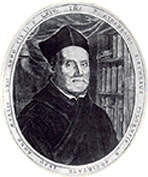
Athanasius Kircher (1602-1680)
Dates
Born: Geisa a. d. Ulster, Germany, 2 May 1602 [or 1601]
Died: Rome, 28 Nov 1680
Nationality
Birth: Geisa a. d. Ulster, Germany
Career: Germany, France, Italy
Death: Rome, Italy
Education
Schooling: Religous Order, D.D.
Lots of study, but all in Jesuit institutions. There is clearly the equivalent of a B.A.
1614-1618, Jesuit Gymnasium in Fulda, learning Greek and Hebrew.
c. 1618-1622, at Paderborn (Jesuit College?), studying humanities, natural science, and mathematics.
After the college was closed due to military pressure, he finished his education in philosophy at Cologne.
1623, at Koblenz, where he took up humanities and languages and taught Greek.
1624, at Heiligenstadt, studying languages and "physical curiosities."
1625-1628, studying theology at Mainz. Being ordained within the Jesuit order and admitted to the fourth vow, he would have had a doctorate in theology.
Function of the automatic water-powered organs
Water is used
- to turn the paddle-wheel which drives the drum with the melody, which moves the keys of the organ, and
- to provide the wind which enters the chest and is used to make the pipes sound.
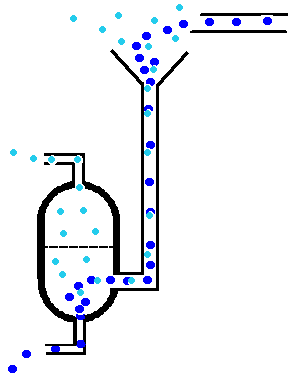
Using a technique which was also employed in the iron-foundries of Italy as early as the the sixteenth century, water is made to enter a long vertical tube, usually with a funnel-shaped opening. In doing so, the water forms a gyre, and sucks air into the tube as well, forming an air-water mixture. At the end of its descent through the tube, the water is separated from the mixture in a special container ("Aeolian chamber"), and may be used to drive a paddle-wheel, as in the case of this organ. The air is allowed to exit via another tube which is connected to the wind chest. No bellows are involved - the pressure is regulated by controlling the flow of water into the system.
The automatic water-powered organs
You hear the Triphonium syncopatum. It should sound as actually being played by a woodwind quartet.
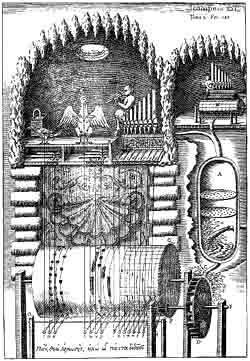
In his book, Musurgia Universalis, published in 1650, we find a thorough description of the automatic water-powered organs of the Italian renaissance.According to Grove's Dictionary of Music, this copper plate depicts the water organ in Villa Aldobrandini at Tivoli. The main part of the instrument has the form of a grotto, in which Pan the satyr plays his flute, accompanied by the cuckoo's call and the rooster's crow. In addition, there is a smaller organ with an effigy of a nymph, known in the Greek mythology as Echo.Hear how he satyr plays a simple theme on his flute, and how the nymph responds with her echo.
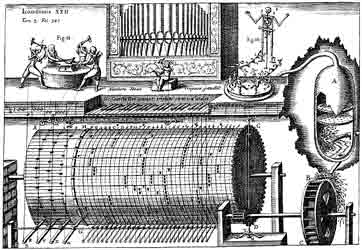
According to Kircher, this large organ has three ranks of pipes, and plays a four-part hymn accompanied by moving figures.The three blacksmiths are a tribute to Pythagoras, who is said to have discovered the harmonic intervals when listening to the sound of hammers in the forge.In addition, the organ's own music is enhanced by a four-part choir singing a Latin text invoking the blacksmiths' mythical patron Vulcanus and praising the glory of Work.
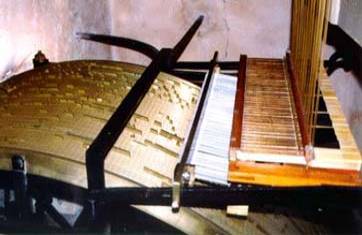
The automatic organ of the Roman Quirinale was built in 1647 by Italian organ builder Matteo Marione, following the designs of Athanasius Kircher.The present organ replaced an older instrument, built in 1596 by Luca Blasi. Since then, it has been restored several times and is still playable.Here we have a look at its ornate facade. Beautiful, isn't it? And by the way, note its resemblance to the organ in the satyr's grotto!
Color photographs from the Italian web site:
The water-powered organ of the Quirinale, Rome.

All automatic organs consist of three parts: The bellows, the windchest and a musical cylinder or barrel, on which the score is notated. The Quirinale organ is powered by water, which is used to drive the mechanism, as well as to compress the outward air before it is let into the windchest.On this picture you can clearly see the cylinder and key frame - which is the automatic organ's equivalent to the keyboard.
Color photographs from the Italian web site:
The water-powered organ of the Quirinale, Rome.

And now for a close look at the keyframe and barrel, on which the pins and bridges (corresponding to short and sustained notes) clearly can be seen.In his book, Athanasius Kircher gives us detailed instructions for pinning the barrel, which he called the cylindrus phonotacticus. He also gives us numerous examples of music appropriate for automatic organs, one of which is a four-part Ricercata by the young Johann Caspar Kerll (1627-1693).
Color photographs from the Italian web site:
The water-powered organ of the Quirinale, Rome
The URL of this page are¡G
http://w1.131.telia.com/~u13101111/kircher/index.html
http://es.rice.edu/ES/humsoc/Galileo/Catalog/Files/kircher.html
http://www.aec2000.it/organum/artec/quirin1.htm#History